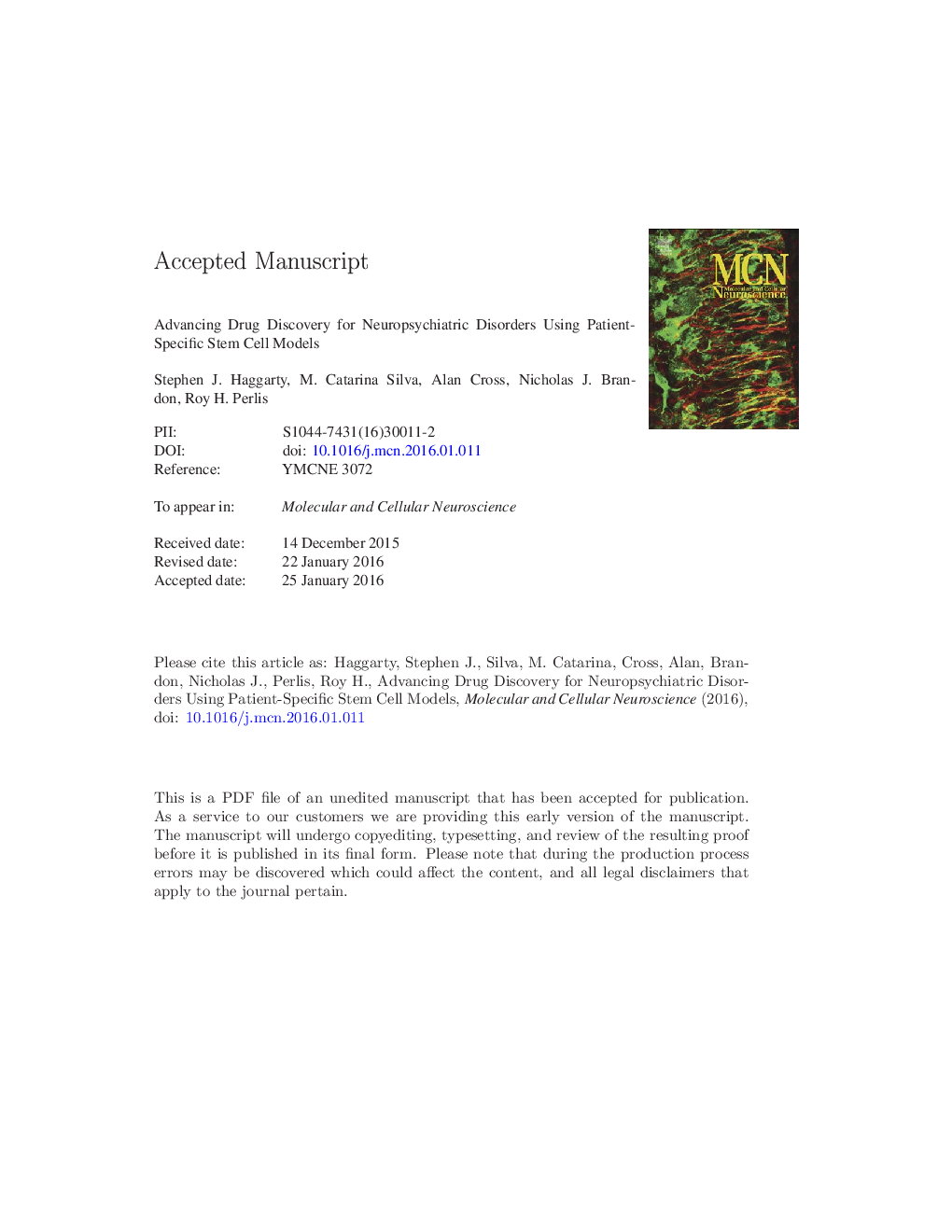| کد مقاله | کد نشریه | سال انتشار | مقاله انگلیسی | نسخه تمام متن |
|---|---|---|---|---|
| 8478494 | 1551133 | 2016 | 35 صفحه PDF | دانلود رایگان |
عنوان انگلیسی مقاله ISI
Advancing drug discovery for neuropsychiatric disorders using patient-specific stem cell models
ترجمه فارسی عنوان
پیشگیری از کشف مواد مخدر برای اختلالات روانپزشکی با استفاده از مدل های سلول های بنیادی خاص بیمار
دانلود مقاله + سفارش ترجمه
دانلود مقاله ISI انگلیسی
رایگان برای ایرانیان
کلمات کلیدی
CRISPR-Cas9bipolar disorder - اختلال دو قطبیautism spectrum disorders - اختلالات طیف اوتیسمSchizophrenia - اسکیزوفرنی یا شیزوفرنیHigh-content imaging - تصویربرداری با محتویات بالاDementia - جنون یا زوال عقلHuman stem cells - سلول های بنیادی انسانیNeuropharmacology - عصب شناسیhigh-throughput screening - غربالگری بالاDrug discovery - کشف مواد مخدر
موضوعات مرتبط
علوم زیستی و بیوفناوری
بیوشیمی، ژنتیک و زیست شناسی مولکولی
بیولوژی سلول
چکیده انگلیسی
Compelling clinical, social, and economic reasons exist to innovate in the process of drug discovery for neuropsychiatric disorders. The use of patient-specific, induced pluripotent stem cells (iPSCs) now affords the ability to generate neuronal cell-based models that recapitulate key aspects of human disease. In the context of neuropsychiatric disorders, where access to physiologically active and relevant cell types of the central nervous system for research is extremely limiting, iPSC-derived in vitro culture of human neurons and glial cells is transformative. Potential applications relevant to early stage drug discovery, include support of quantitative biochemistry, functional genomics, proteomics, and perhaps most notably, high-throughput and high-content chemical screening. While many phenotypes in human iPSC-derived culture systems may prove adaptable to screening formats, addressing the question of which in vitro phenotypes are ultimately relevant to disease pathophysiology and therefore more likely to yield effective pharmacological agents that are disease-modifying treatments requires careful consideration. Here, we review recent examples of studies of neuropsychiatric disorders using human stem cell models where cellular phenotypes linked to disease and functional assays have been reported. We also highlight technical advances using genome-editing technologies in iPSCs to support drug discovery efforts, including the interpretation of the functional significance of rare genetic variants of unknown significance and for the purpose of creating cell type- and pathway-selective functional reporter assays. Additionally, we evaluate the potential of in vitro stem cell models to investigate early events of disease pathogenesis, in an effort to understand the underlying molecular mechanism, including the basis of selective cell-type vulnerability, and the potential to create new cell-based diagnostics to aid in the classification of patients and subsequent selection for clinical trials. A number of key challenges remain, including the scaling of iPSC models to larger cohorts and integration with rich clinicopathological information and translation of phenotypes. Still, the overall use of iPSC-based human cell models with functional cellular and biochemical assays holds promise for supporting the discovery of next-generation neuropharmacological agents for the treatment and ultimately prevention of a range of severe mental illnesses.
ناشر
Database: Elsevier - ScienceDirect (ساینس دایرکت)
Journal: Molecular and Cellular Neuroscience - Volume 73, June 2016, Pages 104-115
Journal: Molecular and Cellular Neuroscience - Volume 73, June 2016, Pages 104-115
نویسندگان
Stephen J. Haggarty, M. Catarina Silva, Alan Cross, Nicholas J. Brandon, Roy H. Perlis,
